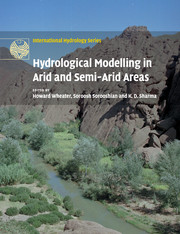Book contents
- Frontmatter
- Contents
- List of contributors
- Preface
- Acknowledgements
- 1 Modelling hydrological processes in arid and semi-arid areas: an introduction
- 2 Global precipitation estimation from satellite imagery using artificial neural networks
- 3 Modelling semi-arid and arid hydrology and water resources: The southern Africa experience
- 4 Use of the IHACRES rainfall-runoff model in arid and semi-arid regions
- 5 KINEROS2 and the AGWA modelling Framework
- 6 Ephemeral flow and sediment delivery modelling in the Indian arid zone
- 7 The modular modelling system (MMS): a toolbox for water and environmental resources management
- 8 Calibration, uncertainty, and regional analysis of conceptual rainfall-runoff models
- 9 Real-time flow forecasting
- 10 Real-time flood forecasting: Indian experience
- 11 Groundwater modelling in hard-rock terrain in semi-arid areas: experience from India
- Appendix Access to software and data products
- Index
- Plate section
- References
5 - KINEROS2 and the AGWA modelling Framework
Published online by Cambridge University Press: 15 December 2009
- Frontmatter
- Contents
- List of contributors
- Preface
- Acknowledgements
- 1 Modelling hydrological processes in arid and semi-arid areas: an introduction
- 2 Global precipitation estimation from satellite imagery using artificial neural networks
- 3 Modelling semi-arid and arid hydrology and water resources: The southern Africa experience
- 4 Use of the IHACRES rainfall-runoff model in arid and semi-arid regions
- 5 KINEROS2 and the AGWA modelling Framework
- 6 Ephemeral flow and sediment delivery modelling in the Indian arid zone
- 7 The modular modelling system (MMS): a toolbox for water and environmental resources management
- 8 Calibration, uncertainty, and regional analysis of conceptual rainfall-runoff models
- 9 Real-time flow forecasting
- 10 Real-time flood forecasting: Indian experience
- 11 Groundwater modelling in hard-rock terrain in semi-arid areas: experience from India
- Appendix Access to software and data products
- Index
- Plate section
- References
Summary
INTRODUCTION
This chapter describes the conceptual model, mathematical model, and numerical methods underpinning the Kinematic Runoff and Erosion Model, KINEROS2. The performance of KINEROS2 and its numerous components has been evaluated in numerous studies, which were described in detail by Smith et al. (1995a). Here we provide an overview of the geospatial interface for KINEROS2, including data requirements and the major steps and methods used to derive model inputs. An example is provided illustrating how KINEROS2 can be used via AGWA for multi-scale watershed assessment. We conclude with a description of current and planned research and development that is designed to improve both KINEROS2 and AGWA and their usability for environmental management and planning.
KINEROS2
KINEROS2 is a distributed, physically based, event model describing the processes of interception, dynamic infiltration, surface runoff, and erosion from watersheds characterized by predominantly overland flow. The watershed is conceptualized as a cascade of planes and channels, over which flow is routed in a top-down approach using a finite difference solution of the one-dimensional kinematic wave equations. KINEROS2 may be used to evaluate the effects of various artificial features such as urban developments, detention reservoirs, circular conduits, or lined channels on flood hydrographs and sediment yield.
KINEROS2 originated at the US Department of Agriculture (USDA) Agricultural Research Service's (ARS) Southwest Watershed Research Center (SWRC) in the late 1960s as a model that routed runoff from hillslopes represented by a cascade of one-dimensional overland-flow planes contributing laterally to channels (Woolhiser, et al., 1970).
- Type
- Chapter
- Information
- Hydrological Modelling in Arid and Semi-Arid Areas , pp. 49 - 68Publisher: Cambridge University PressPrint publication year: 2007
References
- 11
- Cited by



